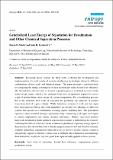Generalized Least Energy of Separation for Desalination and Other Chemical Separation Processes
Author(s)
Mistry, Karan Hemant; Lienhard, John H.
DownloadMistry-2013-Generalized least en.pdf (704.5Kb)
PUBLISHER_CC
Publisher with Creative Commons License
Creative Commons Attribution
Terms of use
Metadata
Show full item recordAbstract
Increasing global demand for fresh water is driving the development and implementation of a wide variety of seawater desalination technologies driven by different combinations of heat, work, and chemical energy. This paper develops a consistent basis for comparing the energy consumption of such technologies using Second Law efficiency. The Second Law efficiency for a chemical separation process is defined in terms of the useful exergy output, which is the minimum least work of separation required to extract a unit of product from a feed stream of a given composition. For a desalination process, this is the minimum least work of separation for producing one kilogram of product water from feed of a given salinity. While definitions in terms of work and heat input have been proposed before, this work generalizes the Second Law efficiency to allow for systems that operate on a combination of energy inputs, including fuel. The generalized equation is then evaluated through a parametric study considering work input, heat inputs at various temperatures, and various chemical fuel inputs. Further, since most modern, large-scale desalination plants operate in cogeneration schemes, a methodology for correctly evaluating Second Law efficiency for the desalination plant based on primary energy inputs is demonstrated. It is shown that, from a strictly energetic point of view and based on currently available technology, cogeneration using electricity to power a reverse osmosis system is energetically superior to thermal systems such as multiple effect distillation and multistage flash distillation, despite the very low grade heat input normally applied in those systems.
Date issued
2013-05Department
Massachusetts Institute of Technology. Department of Mechanical EngineeringJournal
Entropy
Publisher
MDPI AG
Citation
Mistry, Karan, and John Lienhard. “Generalized Least Energy of Separation for Desalination and Other Chemical Separation Processes.” Entropy 15, no. 6 (June 27, 2013): 2046-2080.
Version: Final published version
ISSN
1099-4300